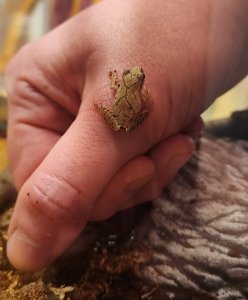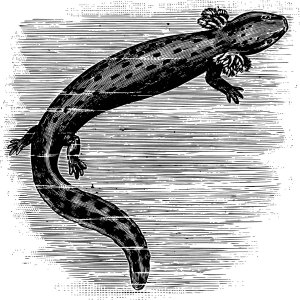Herp’s Declassified Winter Survival Guide: how to freeze without freezing.
October 18, 2023
Ali Groulx, Park Interpreter
We are creeping closer to winter in Michigan, which means a couple of things; the sun has taken to hiding behind dense grey clouds, the deciduous trees are dropping their leaves in an effort to conserve energy, harlequin lady beetles are finding their way into your cozy dwelling, and your local backyard squirrels are erratically burying as many acorns as they can get their paws on. Preparation has begun for the harsh chill that is bound to come. But, where on earth have all the cold-blooded herps gone? These unique animals cannot regulate their temperatures, making them ectothermic, or poikilothermic, which means their internal temperature depends on their environment. Join us as we discover the secrets to winter survival in the wonderful, weird world of herpetology: the study of reptiles and amphibians.
Have you ever seen a spring peeper? These itty-bitty amphibians are the smallest frogs in Michigan

at only two centimeters long. Spring peepers are aptly named. As the long, chilly winter slowly morphs into spring, they begin peeping loudly as soon as they thaw… yes, thaw! To survive the incoming cold, peepers start to make changes in their bodies on a cellular level; each cell in the peeper’s body expels water, replacing it with extra glucose created in their tiny livers. By replacing most of the water in their cells with sugar-laden glucose, the water that remains will not freeze. If ice crystals formed, they would stab the peeper’s insides! The glucose they produce is understood to act as an ‘anti-freeze,’ functioning similarly to the anti-freeze that prevents car engines from freezing. Spring peepers do have a limit; they may die if their internal temperature drops under 21°F. They choose to tough out the winter under leaves or soil on the forest ground. This, coupled with snow cover, can act as an insulator against extreme cold. As spring approaches, the little peeps emerge, letting everyone know that they are awake with their loud peeping efforts to find a mate for the spring.
Not all amphibians turn into peep-sicles… surprisingly, winter is the best time of year to observe and study mudpuppies. Mudpuppies are a type of aquatic salamander that lives in the Great Lakes basin. The adults are kind of like perpetual teenagers; most adult salamanders leave their aquatic habitats and external gills behind, but not the mudpuppy. They remain water-breathing, walking along the riverbed they call home. Here, waters do not dip below freezing, allowing mudpuppies to carry on with business as usual. Scientists utilize this cool creature’s winter mobility by setting up small traps to catch them for data gathering. They are extremely careful to keep the mudpuppies in water during this process because their health deteriorates rapidly once exposed to frigid air. Ice fishers who accidentally catch them are encouraged to remove any hooks before releasing them back into their watery home. It is important to return mudpuppies to the water. As an indicator species, mudpuppies are sensitive to pollutants and their presence, or lack thereof, can indicate the health of a body of water. This provides valuable insight into the quality of our fresh waters.

All water-dwelling creatures are not created equal. While the mudpuppy carries on like winter is not happening, aquatic reptiles like snapping and painted turtles must face a challenge… how does one continue to survive without food or oxygen? Snapping turtles, like mudpuppies, enjoy hanging out on the riverbed, but these reptiles breathe air. Surfacing for a breath puts them in danger of freezing, so they begin to brumate alongside painted turtles. Brumation means that an animal is still conscious, but their bodily processes and movements are slowed down to allow for their energy supply to last. How do turtles hold their breath for the whole winter? Enter, butt breathing. Turtles can take in oxygen through their butts when they are underwater. Scientifically speaking, oxygen from the water is absorbed through parts of their body that are filled with blood vessels, like the cloacal opening. The cloaca is a versatile orifice, used for excreting waste, mating, laying eggs, marking territory, and surviving hypoxic, or low oxygen, environments. A change in bodily functions like this can result in a buildup of lactic acid. For snappers and painted turtles, the calcium in their bones and shells neutralizes the acid, allowing them to protect their internal tissues from damage. Baby painted turtles, however, do something unique for their first winter. After they hatch out of their eggs in the fall, they remain in their underground nest, staying there together until spring. These hatchlings can withstand colder temperatures than their adult parents. Snappers, blanding’s turtles, and map turtles will utilize this strategy occasionally, but not as often as painted turtles. Most aquatic turtles and their hatchlings will seek water to overwinter. Land turtles, like the box turtle, brumate after burying themselves in a hole below the freeze line. By reducing their metabolism and living off stored fat, they can stay buried until the soil around them reaches 50°F.
The Massasauga rattlesnake’s hibernation location depends on certain requirements. Massasaugas are a threatened species in Michigan, and they do not take well to changes in their hibernacula, or hibernating spot. Massasaugas prefer small mammal burrows or crannies in root systems as their hibernacula, stowing themselves away for the winter. An early cold snap in the fall can trick a snake into bromating early, but they will return to the surface when temperatures rise again. Massasaugas and other bromating snakes have been known to emerge during warmer, sunny winter days, but typically stay in their hibernacula until spring.
Extending our curiosity to our ectothermic pals in the wintertime shows us the strong determination they possess to survive harsh conditions. Whether they are holding their breath, turning into peep-sicles, stashing themselves away, or carrying on as usual, the obstacles that herps overcome to make it through the winter are intense. We can help these creatures by finding value in their lives, leaving leaf litter and debris, and paying attention to the ecosystems we host in our backyards and communities. If you were a herp, how would you choose to spend the winter?
Sources and Further Reading:
Winter: An Ecological Handbook by James C. Halfpenny and Roy Douglas Ozanne
Amphibians and Reptiles of the Great Lakes Region by James H. Harding
